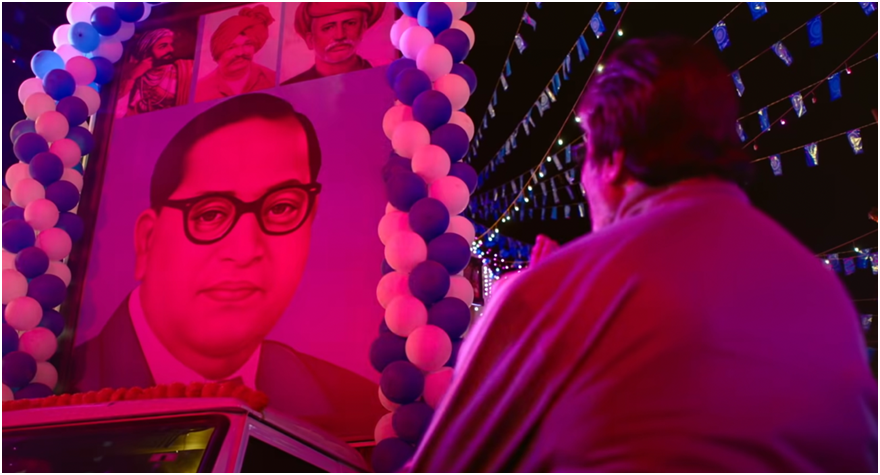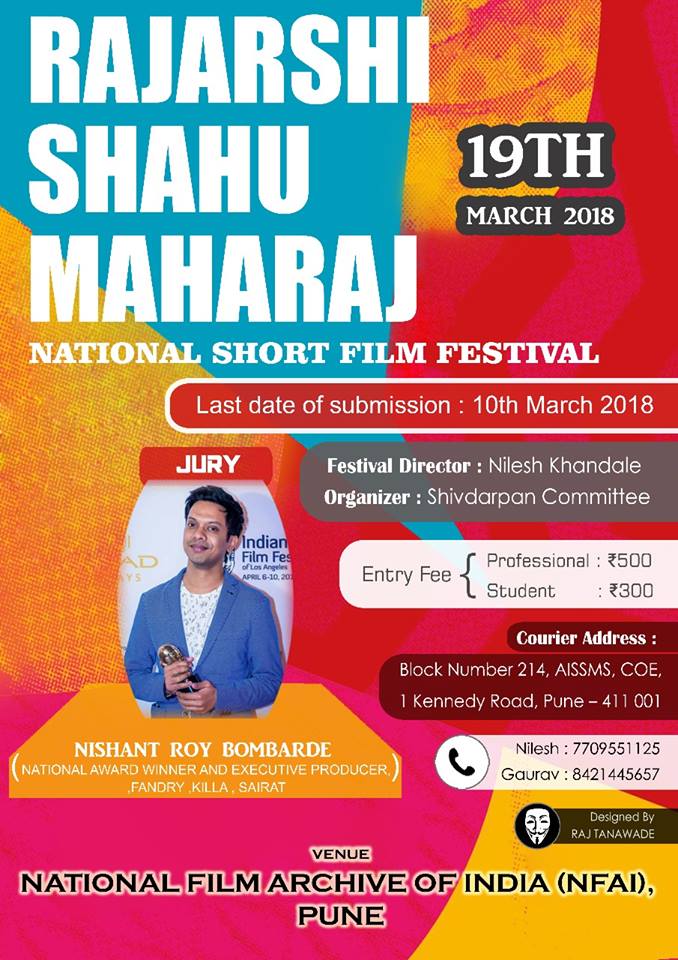Shiva Thorat
This is a pre-watch review of Nagraj Manjule’s Jhund. It unravels the emotional outpouring for Jhund and the connection and belongingness felt with the lyrics of the song “Lafda Jhala Wakda Tikda”. It is also about a group of young people in the town of Shirpur who made enormous efforts to get a screen for Jhund.
One Facebook post on the film suggests that Jhund was able to acquire only 900 screens, whereas Pawankhind—a Marathi film showcasing life of Bajirao Prabhu Deshpande—got 1450 and Gangubai Kathiawadi—a biopic of a sex worker played by Alia Bhatt and directed by Sanjay Leela Bhansali—was given the privilege of around 4500 screens. On top of that, DC’s The Batman managed to acquire 1200 screens all over India. Of the 900 screens given to Jhund, 200 screens were in Mumbai alone. Whether this data is true or false, I just want to talk about one screen—in my hometown—and the emotional attachment and belonginess a group of young people there felt with Nagraj Manjule’s Jhund.

Image 1:Flags from the song ‘Lafda Jhala Vakda Tikda’
One of the most viral predictions about Jhund is that it won’t be able to recover its budget. An anonymous Facebook post countered this by saying “it’s our story. If the movie doesn’t earn its budget, we will ourselves work to eliminate the risk Nagraj Manjule has taken in making this film and will together find a way to recover the budget.” This extraordinary intensity of the real world that connects the audience to the screen culture and shows a deep-level of engagement and investment with the movie’s pseudo-subject as a real subject. This makes Jhund very special. Among many others connections with Jhund is members of the audience interacting with ‘each other’. And it’s not a new phenomenon. In South India, the sense of belongingness audiences have for the screen and its stories and personae is also strong.
With Jhund, this connecting of the screen and audience also happened in my hometown – Shirpur. A group of Nagraj Manjule’s fans went to a theatre owner and asked him why he is not allowing Jhund to release in Shirpur? Initially, the owner was frightened and didn’t give proper answers. Understanding the situation, the fans then went back to think of strategies, discussed it among themselves and returned to the theater owner and asked him what is the risk he doesn’t want to take by screening Jhund? He expressed freely then that Jhund is not making much money. Here I have observed that the emotions that Nagraj has used and implemented so well through the film, is contributing to entire film and sociological theory.
Sandesh Thorat, a painter by occupation and social activist in Shirpur, expressed that, “Manjule’s Fandry is a good example of socio-economic and psychological differences and Sairat was a reflection of society’s cruel reality. It’s all real. Jhund is first Hindi film opportunity for Manjule and he has managed to show Jayanti in it. Jhund has affected us emotionally. One of the houses that I am painting belongs to the Taluka President of Hindu Mahasabha. He didn’t think that I am educated and vocal about social issues. He was talking about Jhund and that too very negatively. I did not interrupt him then but I told him to watch the movie when it is screened in Shirpur.”
Babasaheb Ambedkar’s Jayanti (birth anniversary) is celebrated using mass contributions (or crowd sourcing as it is called now) in every village, town, city and pada of Maharashtra, and recently also in other states of India. In Shirpur too, it’s a huge event. There is only one committee which manages the Jayanti for the entire town. People choose the president and committee members in a public meeting. The picturization of Jhund’s song—Lafda Jhala Wakda Tikda— is a realistic illustration that is very relatable to the process of Jayanti in Shirpur.

Image 2: Still from the song ‘Lafda Jhala Vakda Tikda’
Now let me tell you a little bit about Shirpur. It is a taluka in Dhule district of the Khandesh region of Maharashtra. Shirpur is famous for two things: its profit-driven educational market and its water purification plant. Besides these, it is also famous for its non-Bramhin movement led by late Shivajirao Patil, who was MP and MLA of the region. And also for Vyankatrao Randhe, an educationist and reformer who made education available for free to Dalits, Bahujans and Adivasis. For the last 35 to 40 years, there were three theatres in Shirpur. Before the theatres arrived, moving and open talkies used to come during winter Jatra period in the vicinity. It was rare in Khandesh region to have open and moving talkies and to have three theatres in one taluka. The three talkies were Datta Talkies, that screened soft porn films and A grade movies, mostly. The other two were Bhandari and Alankar talkies, which played Marathi, Hindi and Bollywood films. As the dubbed movie industry boomed in the past 15 years, they also started screening dubbed movies on demand.
The COVID pandemic has affected theatres all over the world, and also in Shirpur. Datta and Bhandari talkies had to shut down; in fact, Datta talkies is currently in ruins. Alankar talkies has other businesses running within its campus. The owner of Alankar talkies, Mr. Agrawal, is well connected with the local politicians. Right now, Alankar talkies is playing Pawankhind—a movie on the life of Baji Prabhu Deshpande who died fighting for Shivaji’s swaraj.

Image 3: Youth who want Jhund on the big screen in Shirpur
A kind of emotional strategy was adopted for marketing Pawankhind which I find so hilarious. I will tell one instance for now, which went viral, and said—’sell waste paper of your house and watch Pawankhind’. Doesn’t it come across as trying to induce one to sell books in the house? Anyway, according to one of the activists who wants Jhund on the big screen,“Pawankhind is anyway not earning well and Mr. Agrawal is hesitating to play Jhund because he has been warned by the Maratha mob.” The activist also told me that, “this has always been the situation with theatres. Even at the time of protests against Aaja Nachale—a Madhuri starrer—the behavior of the owners of Alankar and Bhandari talkies was backed and controlled by the Shiv Sena and BJP.” The controversy was about the lyrics using the words Chamar and Sonar depicting their hierarchical occupational positions in society.
Dada Shirsath who leads that group, discussed why Manjule’s Jhund is a very important movie of present times. He says, “Apni Film, Badi Parde pe honi hi chahiye (Our film has to be on the big screen), and there is a good social message that the movie is representing. If casteist people don’t want to leave their casteism and want to continue with their stigmatized notions, we still have to live our life anyway. We will force them to screen Jhund on Bada Parda because we want to see it and want to show the process of Jayanti celebration. And we will dance on Lafda Jhala Wakda Tikda.” Such discourse has created a great amount of interactionist symbolism amongst the audience with Jhund. Jhund’s advertisements and market publications also used the phrase “Badi Film, Bade Parde Par”. From Friday, Alankar talkies will play two shows of Jhund—in the afternoon at 11.30 am and 2.30 pm.
The intensity of emotions that are flowing amongst the audience in Shirpur for Jhund is a marvelous opportunity to understand popular culture and the politics of screen. The efforts of audience to get Jhund on the screen in Shirpur is tied to their commitment towards highlighting how screen culture has always been dominated by the upper caste, powerful people in the region. Uday Sapkale, 12thstandard student and another fan of Manjule’s work who wanted “Apni Film Bade Parde Par”, agrees to the politics of sentimentality and polarizations of Marathi, Hindi and Tollywood film as a strategy. “No one can deny that Jhund speaks directly to the sentimentality and emotions of the audience and makes them feel it’s a story that needs to be told.” Manjule even played the drums in Pune city on its release date.
In Hindi movies, artistic and thoughtful kind of cinema is considered to be a standard and a signifier of class. Director Jabbar Patel and Sumitra Bhave are good examples of the filmmakers of that cinema. Mass movies are not considered classy cinema. The recent movies—Article 15 (2019) by Anubhav Sinha and Masaan (2015) by Neeraj Ghaywan—have been celebrated as artistic and thoughtful kind of cinema representing caste violence. But both of them didn’t appeal to the audience as Jhund did. Parallel cinema of 1970s, 80s and 90s too has this classy identity, and yet they failed to get the audience. As we see, cinema is also a mirror of society—Jhund represents this mirror. It is also artistic and thoughtful cinema as it is thought provoking and disturbs the masses, whether in support or against. Jhund is providing an important contribution to the concepts of film theory with its pragmatic approach. It has started a symbolic interaction even before its release. And after the release, it is providing theoretical factors and aspects to the methods of psychoanalytic processes of sociology by nourishing film theory.
Film theory aside, one such case is that the face of Amitabh Bachchan made many people watch the movie. Akshat Jain wrote in an article in countercurrents, “Jhund is a family movie which makes perfect use of Amitabh Bachchan to increase its reach into the viewing times of the upper caste. It grabs their eyeballs, so as to speak. Amitabh Bachchan is used as a token to pull affluent audiences in a brilliant coup de grace by Manjule.” The second issue that nourishes its contribution to film theory is that it draws a clear line between the haves and the have nots, whether they are upper caste, Dalit or Bahujan. High and low cultures are depicted on screen, with the difference between them being those who disregard slums and those who think masses reside in the slums. Vijay Ahire, poet, singer and musician, said that “their Vijay Dinanath Chauhan became our Vijay Sir.”

Image 4:Amitabh Bachchan paying tribute to Dr Ambedkar
करेनहींबोलबच्चन Karein Nahi Bol Bachchan
खालीपीलीनहींभोंकते Khali Pili Nahi Bhonkate
सटकेजोअपनामगज Satke Jo Apna Magaj
हमकसकेदहाड़दे Hum Kaske Dahad De
As a viewer and media practitioner, I have realized that portraying Jayanti on the screen is a difficult task. I haven’t seen the Marathi movie Jayanti (Narwade, 2021), which again portrays the process of King Shivaji’s Jayanti and I have heard that it’s also a good movie. Manjule has said several times that his agenda of making Jhund is to portray the people who are unheard and ignored. There are a lot of views working for and against his agenda of portraying Jhund which Manjule tackles by appearing with someone who is big in the film industry and electoral politics. Everyone is friendly to him and of course there is criticism but he and his team are tackling them carefully.

Image 5 is from trailer
Jayanti is an emotional and ideological event for Dalits in rural areas, and pragmatic and political for Bahujans in urban areas. Manjule’s Jhund has had a good impact and has started a discourse in the mainstream. Manjule’s film gets the benefit of emotions of the slum for Jayanti, for trying to bring a change and set a new alternate trend in the history of Hindi cinema. Philanthropist and Satyamev Jayate fame Aamir Khan too wants to work under his direction – he expressed so after a private screening of the film just before the release date. The image in the song Lafda Jhala Vakda Tikda where Bachchan is paying homage to Babasaheb Ambedkar at Jayanti is the risk that Manjule has accepted and worked for. One of the posts on Facebook expressed that, “now Bachchan has been humanized”. This act of playing a cultural broker in the Hindi cinema has helped Manjule create a new regime of portraying reality cinematically – with the film industry and the market mediating. Manjule has stated that, “only talking about caste can erase caste”.
Whether Jhund earns back its budget or not won’t be a concern in the future. It has already imprinted an important discussion on ideology of Hindi cinema. Everyone suddenly is emotional. Jhund has brought the factor of the popular concept of Jayanti into cinema and that is why it has evoked confessions from many celebrities, politician, social theorists and common masses. Several videos, and written confessions by names like Aamir Khan to Tamil star Dhanush, Jitendra Joshi to Sunil Sukhtankar, Subodh Bhave to Siddharth Jadhav, Anurag Kashyap to Riteish Deshmukh are going viral in social media. The list of confessions made by people goes too long but most of the writings and confessions express their belongingness to Jhund. There is a lot of scripted criticism on the film by mainstream film critics of Bollywood already – but the active audience of Jhund is taking those criticisms personally and trying to answer back, and defend the film as if they are defending themselves. This has never happened to any film in the history of Hindi cinema.
~
Shiva Thorat is Navi Mumbai based independent filmmaker who is working on post production of his documentary – Mangroves – Mumbai’s Last Guard.










